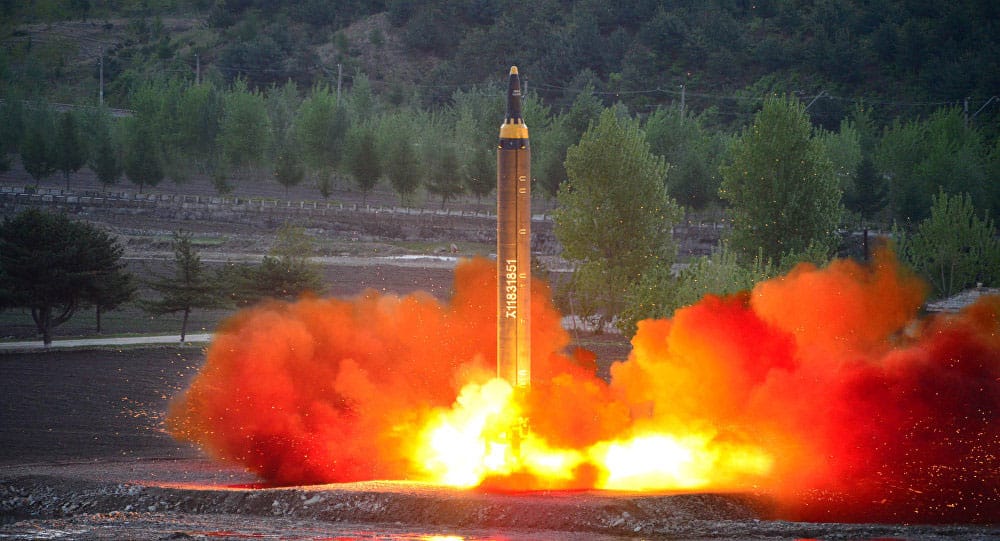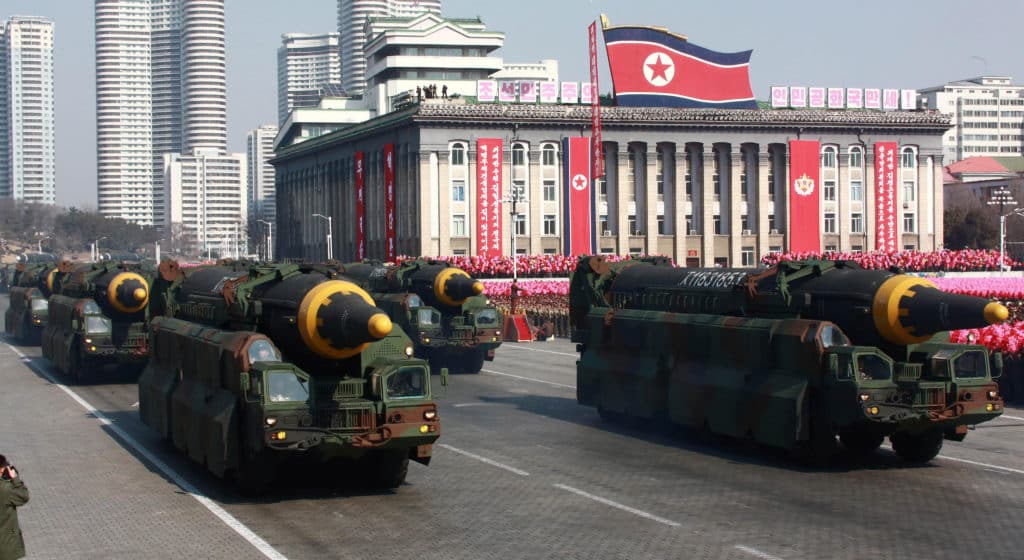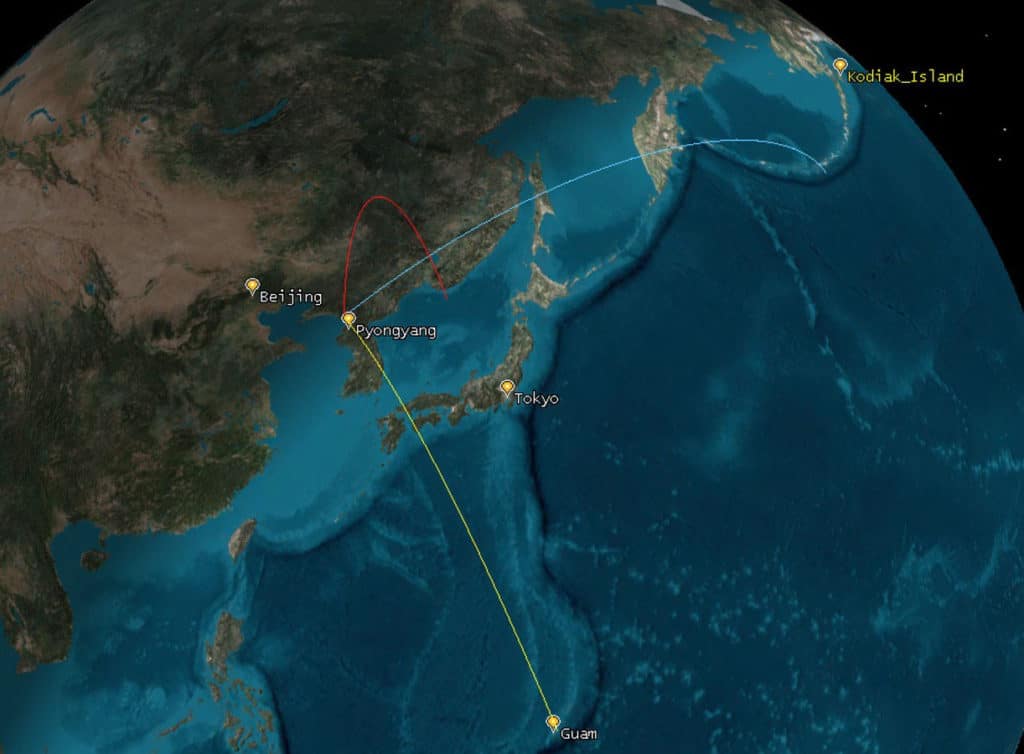The Hwasong-12 (KN-17) is a North Korean intermediate-range ballistic missile. It has a range of 4,500 kilometers. It was successfully test-launched for the first time on May 14, 2017.
Hwasong-12 at a Glance
- Originated from
- North Korea
- Alternative name(s)
- KN-17
- Possessed by
- North Korea
- Class
- Intermediate-range ballistic missile (IRBM)
- Basing
- Road-mobile transporter-erector launcher
- Length
- 17.4 m
- Diameter
- 1.65 m
- Launch weight
- Unknown
- Payload
- Single warhead, 500 kg
- Warhead
- Nuclear or conventional
- Propulsion
- Single-stage, liquid propellant
- Range
- 4,500 km
- Status
- In development



Hwasong-12 Development
The Hwasong-12 first appeared in North Korea’s “Day of the Sun” parade on April 15, 2017. It was speculated at the time that it could be a shortened version of North Korea’s untested KN-08 ICBM. The missile was carried on a vehicle previously associated with the BM-25 Musudan IRBM.1 Evidence from the missile’s first test launch on May 15, however, indicates a single-stage design.
North Korea has flight tested the Hwasong-12 at least seven times, achieving four successful flights and three failures.
The first test of the Hwasong-12 likely occurred on April 5, 2017 from Sinpo in the South Hamgyong province of North Korea. According to U.S. Pacific Command, the missile flew a distance of 60 km and reached a height of 189 km before starting to “pinwheel,” landing into the Sea of Japan after 9 minutes of flight time.2 Reports suggest that the missile “pinwheeled” out of control and was considered a failure by US and South Korean officials.3
Date Number Launched Notes January 30, 2022 1 Lofted trajectory. September 14, 2017 1 Flight time: 19 min; distance traveled: 3,700 km; apogee: 770 km. August 28, 2017 1 Flight time: 14 min; distance traveled: 2,700 km; apogee: 550 km. May 14, 2017 1 Flight time: 30 min; distance traveled: 787 km; apogee: 2,111 km. April 29, 2017 1 Flight time: 15 min; distance traveled: 35 km; apogee: 71 km; broke up during flight. April 16, 2017 1 Exploded seconds after launch. April 5, 2017 1 Flight time: 9 min; distance traveled: 60 km; apogee: 189 km; reportedly “pinwheeled” out of control.
The second suspected launch occurred on April 16, 2017, from the same base in Sinpo and was also considered a failure, exploding seconds after launch.4
The third suspected Hwasong-12 test occurred on April 29, 2017. The missile is presumed to have launched from Pukchang airfield and flew approximately 35 km before crashing.5
The first successful Hwasong-12 test occurred on May 15, 2017 from a location near the the city of Kusong at 04:58 local time on May 14, 2017.6 During the test, the missile was transported on a what appeared to be Musudan transporter-erector launcher (TEL). Rather than directly fired from the TEL, however, it was placed onto a platform for the launch.
On its 30-minute flight, the Hwasong-12 flew 787 kilometers, lofted to an apogee of just over 2,111 kilometers. This trajectory indicates that the missile could have flown around 4,500 km if fired on a range-maximizing ballistic trajectory. This range would put the U.S. territory of Guam and the far western tip of the Aleutian Islands chain within reach (see illustration).7 It should be noted, however, that without an indication of the weight of the payload, a precise range estimate remains speculative. According to one technical analysis of the launch, the full range of the Hwasong 12 could be closer to 3,700 km with a 650 kg payload. This estimate assumes that the Hwasong-12 launched on May 14 carried an empty payload weighing only 150 kg.8
The second successful test occurred on August 28, 2017, in which North Korea flew the missile over the northern Japanese island of Hokkaido. Launched from a site north of Pyongyang shortly before 6 a.m. Japan local time, the missile reportedly traveled over 2,700 km before landing in the Pacific Ocean.9
On September 15, North Korea carried out its sixth (third successful) Hwasong-12 test, again flying the missile over the northern Japanese island of Hokkaido. Launched from Sunan just north of Pyongyang, the missile flew for 19 minutes, traveling 3,700 km, reaching an altitude of 770 km, and landing 2,200 km off the east coast of Japan in the Pacific Ocean. Unlike previous tests, the missile was fired directly from a TEL rather than a concrete platform, an indication of North Korea’s confidence in the Hwasong-12’s reliability.
Specifications
The Hwasong-12’s propulsion system appears to be a variant of the Russian RD-250 rocket engine, the motor used on the Russian SS-18 ICBM. North may have conducted ground tests of this engine design in March 2017, just before the first Hwasong-12 flight test.10 The main engine is accompanied by Vernier thrusters that could provide stability without the need for external fins, like the grid fins previously seen on North Korea’s KN-11and KN-15 medium-range missiles. This new engine design appears to be distinct from the KN-08 and KN-14, which are believed to use 4D10 engines reverse-engineered from imported Russian SS-N-6 submarine-launch ballistic missiles.11
According to the Korean Central News Agency, the Hwasong-12 is “capable of carrying a large-size heavy nuclear warhead.”12
The Hwasong-12 was first speculated to be a modification of North Korea’s KN-08 ICBM. The characteristics of the Hwasong-12 gleaned from the May 14 test, such as engine type and launch apparatus, confirm it is from a different line of design entirely.
Service History
In October 2020, North Korea displayed six Hwasong-12 missiles on TELs at a military parade in Pyongyang. It remains unclear if North Korea has operationally deployed the missile.
Footnotes
- Ian Williams & Thomas Karako, “North Koreas New Missiles on Parade,” CSIS Commentary, April 18, 2017, https://www.csis.org/analysis/north-koreas-new-missiles-parade.
- “North Korea test-fires missile into sea ahead of Trump-Xi Summit,” Ju-min Park and Jack Kim, Reuters, April 5, 2017, http://www.reuters.com/article/us-northkorea-missiles-idUSKBN1762XX.
- Ibid.
- “Pentagon Announces Review of Nuclear Posture amid North Korea Tensions,” Lucas Tomlinson, Fox News, April 17, 2017, http://www.foxnews.com/politics/2017/04/17/pentagon-announces-review-nuclear-posture-amid-north-korea-tensions.html.
- “North Korea’s Missile Test Fails, US Military Says,” Ryan Browne, CNN, April 29, 2017, http://www.cnn.com/2017/04/28/world/north-korea-missile-launch/.
- Choe Sang-Hun, “North Korea Launches a Missile, Its First Test After an Election in the South,” The New York Times, May 13, 2017, https://www.nytimes.com/2017/05/13/world/asia/north-korea-missile-test-kim-jong-un-moon-jae-in.html?_r=0.
- Todd Harrison, Twitter Post, March 15, 2017, https://twitter.com/ToddHarrisonDC/status/864178196429905920.
- Ralph Savelsberg, “A Quick Technical Analysis of the Hwasong-12,” 38 North, May 19, 2017, http://38north.org/2017/05/hwasong051917/.
- Anna Fifield, “North Korean missile flies over Japan escalating tensions and prompting an angry response from Tokyo,” Washington Post, August 28, 2017, https://www.washingtonpost.com/world/north-korean-missile-flies-over-japan-escalating-tensions-and-prompting-an-angry-response-from-tokyo/2017/08/28/e1975804-8c37-11e7-9c53-6a169beb0953_story.html?tid=a_inl&utm_term=.717df0e1fc3e.
- Jeffrey Lewis & Scott Lafoy, “The Hwasong 12, finally,” Arms Control Wonk Podcast, May 15, 2017.
- CSIS Missile Defense Project, “KN-08/Hwasong 13,” Missile Threat, August 8, 2016, https://missilethreat.csis.org/missile/kn-08/.
- “Kim Jong Un Guides Test-Fire of New Rocket,” Korean Central News Agency, May 15, 2017.